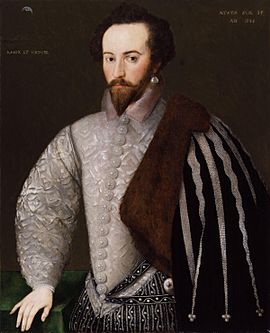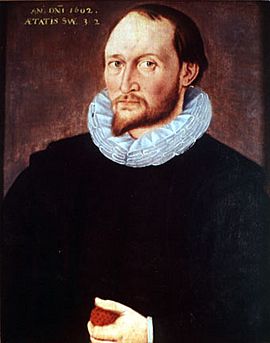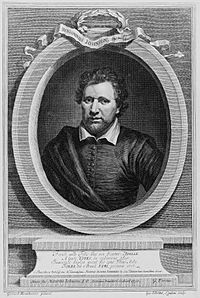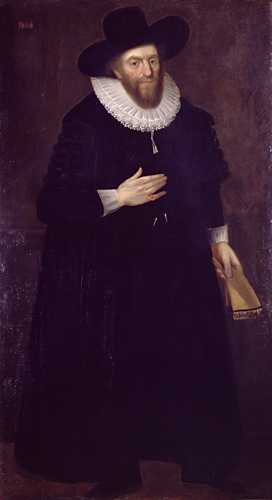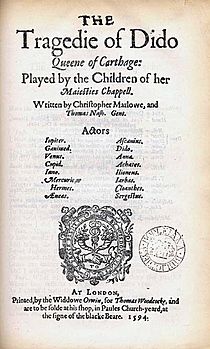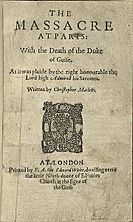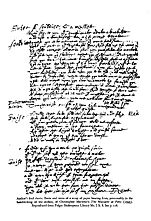Christopher Marlowe facts for kids
Quick facts for kids
Christopher Marlowe
|
|
|---|---|
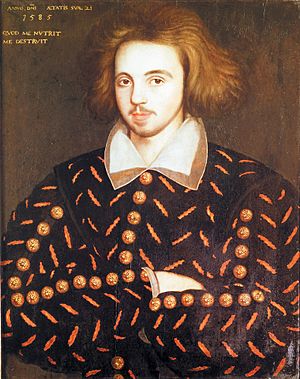
Anonymous portrait, possibly Marlowe, at Corpus Christi College, Cambridge
|
|
| Born |
Canterbury, Kent, England
|
| Baptised | 26 February 1564 |
| Died | 30 May 1593 (aged 29) Deptford, Kent, England
|
| Resting place | Churchyard of St. Nicholas, Deptford, Kent, England; unmarked; memorial plaques inside and outside church |
| Alma mater | Corpus Christi College, Cambridge |
| Occupation |
|
| Years active | 1564–93 |
| Era | |
|
Notable work
|
|
| Movement | English Renaissance |
| Parents |
|
Christopher Marlowe, also known as Kit Marlowe (/ˈmɑːrloʊ/; baptised 26 February 1564 – 30 May 1593), was a famous English playwright, poet, and translator. He lived during the Elizabethan era, a time when Elizabeth I was Queen of England. Many people consider Marlowe one of the most important playwrights of his time.
Experts believe he was the top dramatist in London just before his mysterious death. Some even think he had a big influence on William Shakespeare. Shakespeare was born in the same year as Marlowe. Marlowe was the first to become famous for using blank verse in plays. This style of writing, which doesn't rhyme, became very popular. His plays often feature main characters who want to achieve great things.
Marlowe's life was sometimes as dramatic as his plays. There are many different stories about how he died in 1593. These stories are still debated today because there isn't much clear information. Some ideas include a fight, or even espionage (secret spy work). An official report about his death came out in 1925. But it didn't answer all the questions about his life.
Contents
Marlowe's Early Life and Education
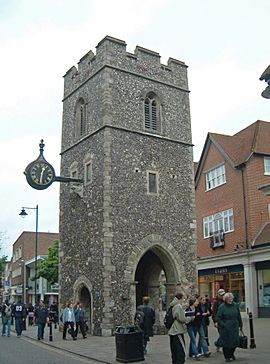
Christopher Marlowe was the second of nine children. He was the oldest child after his sister Mary died in 1568. His father, John Marlowe, was a shoemaker in Canterbury. His mother, Katherine, was the daughter of William Arthur from Dover. Christopher was baptised at St George's Church in Canterbury on February 26, 1564. He was likely born a few days before that date. This means he was about two months older than William Shakespeare. Shakespeare was baptised on April 26, 1564.
When he was 14, Marlowe attended The King's School in Canterbury. He had a scholarship to help pay for his studies. Two years later, he went to Corpus Christi College, Cambridge. He also had a scholarship there. People expected him to become a clergyman in the Church of England. But he earned his Bachelor of Arts degree in 1584 instead. Marlowe became very good at Latin during his studies. He read and translated works by the Roman poet Ovid.
In 1587, the university was unsure about giving him his Master of Arts degree. There was a rumor that he planned to go to a Catholic seminary in France. Becoming a Roman Catholic priest was against Queen Elizabeth I's laws. These laws were put in place to protect England. They were a response to conflicts between Protestants and Catholics in Europe.
Despite the rumors, Marlowe received his degree on time. The Privy Council (the Queen's advisors) helped him. They praised him for his "faithful dealing" and "good service" to the Queen. The Council did not say what kind of service Marlowe had done. This has led many experts to believe he was a secret agent. They think he worked for Sir Francis Walsingham, a member of the Privy Council. The Council's letter was vague. It said people should not criticize those who served the country. This kind of language was often used to protect government agents.
Marlowe's Adult Life and Mysteries
Not much is known about Marlowe's adult life. Most of what we know comes from legal papers. Many writers have guessed about his jobs and personal life. Marlowe has been called a spy, a fighter, and someone who didn't believe in God. He was also called a "magician" and a "duellist." While some experts disagree, others say these rumors might have some truth. People still wonder about his secret spy work. They also question his beliefs and the strange way he died.
Was Marlowe a Spy for the Queen?

Many people think Marlowe was a government spy. Some experts believe he was recruited while at Cambridge. In 1587, the Privy Council told Cambridge University to give Marlowe his degree. They said he had been involved in important "affaires" for his country. University records show Marlowe was often away from college. This was unusual and against the rules.
His college accounts also show he spent a lot of money on food and drink. This was more than his scholarship allowed. This suggests he might have had another source of income. This extra money could have come from his secret work.

Some think Marlowe was a tutor to Lady Arbella Stuart in 1589. Arbella was a relative of the Queen. She was also a possible heir to the throne. If Marlowe was her tutor, he might have been spying on her. However, other records show Marlowe was in London at that time. He was involved in a fight and spent some time in prison.
In 1592, Marlowe was arrested in the Netherlands. He was accused of making fake coins. This might have been part of a spy mission. He was sent to the Lord Treasurer, but no charges were filed. He might have been trying to get close to Catholic plotters.
What Were Marlowe's Beliefs?
Marlowe was rumored to be an atheist. In his time, this was a dangerous accusation. It meant being an enemy of God and the state. People feared that atheism was linked to disloyalty to the Queen.
Some historians think Marlowe's claims of atheism were just a cover. They believe it helped him in his spy work. An informer named Richard Baines accused Marlowe of having "damnable judgment of religion." Baines claimed Marlowe made fun of the Bible. He also suggested Marlowe had Catholic sympathies.
Other people, like Thomas Kyd, also reported similar things. Kyd and Baines linked Marlowe to a group around Walter Raleigh. This group was sometimes called the "School of Atheism." One document claimed Marlowe could give "more sound reasons for Atheism than any divine in England."
Some critics believe Marlowe put these ideas into his plays. They think he connected with his rebellious characters. Plays had to be approved before they could be performed. The Archbishop of Canterbury controlled what was published. It seems most of Marlowe's works were considered acceptable.
How Did Marlowe Die?
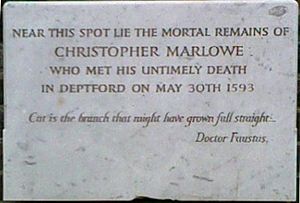
In May 1593, threatening messages appeared in London. These messages targeted Protestant refugees. One message, signed "Tamburlaine," mentioned Marlowe's plays. On May 11, the Privy Council ordered arrests. The next day, Marlowe's friend Thomas Kyd was arrested. Police found a religious paper in his room. Kyd said it belonged to Marlowe. He claimed they had been writing together.
Kyd later described Marlowe as someone who spoke against religion. He called him disorderly and disloyal. Both men had been working for a wealthy patron. A warrant for Marlowe's arrest was issued on May 18. The Council knew he might be staying with Thomas Walsingham. Thomas was a relative of Sir Francis Walsingham, a key figure in state spying.
Marlowe showed up on May 20. He was told to report to the Council daily. On May 30, Marlowe was killed. He was buried in an unmarked grave on June 1, 1593. This was right after the official investigation.
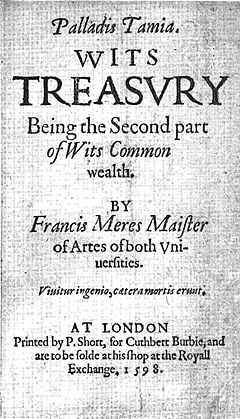
The official report said Marlowe was killed in a fight. It happened at a house in Deptford. He was with three men: Ingram Frizer, Nicholas Skeres, and Robert Poley. They were arguing over the bill for food and drink. Frizer stabbed Marlowe above the eye, killing him instantly. Frizer claimed it was self-defense. He was later pardoned. Many people still find this story hard to believe. They think there might be more to his death.
Marlowe's Influence on Other Writers
Other writers of his time greatly admired Marlowe. Just weeks after his death, George Peele called him "Marley, the Muses' darling." Ben Jonson praised "Marlowe's mighty line," referring to his powerful poetry. Thomas Nashe spoke fondly of his friend, "poor deceased Kit Marlowe."
The most famous tribute came from William Shakespeare. In his play As You Like It, Shakespeare quotes a line from Marlowe's poem Hero and Leander. He also seems to refer to Marlowe's death. The line "a great reckoning in a little room" might be about the fight over a bill. It also connects to a line in Marlowe's play The Jew of Malta: "Infinite riches in a little room."
Shakespeare was very much influenced by Marlowe. You can see Marlowe's ideas in Shakespeare's plays. For example, Antony and Cleopatra and The Merchant of Venice show Marlowe's themes. Even in Hamlet, there's a speech that reminds people of Marlowe's Dido, Queen of Carthage.
Marlowe's Literary Works
Plays by Marlowe
Experts believe Christopher Marlowe wrote or helped write six plays. We don't always know the exact order they were written. Dido, Queen of Carthage is thought to be his first play performed. But Tamburlaine was the first to be shown regularly in London in 1587. Many scholars think Tamburlaine was his biggest success. It was the first English play written in blank verse. It helped start the important period of Elizabethan theatre.
Marlowe might also have written or co-written Arden of Faversham.
Marlowe's Poetry and Translations
Marlowe's poems and translations were mostly published after his death. Some of his notable works include:
- Amores: His translation of Latin poems by Ovid. Copies were publicly burned in 1599 because they were considered offensive.
- The Passionate Shepherd to His Love: A popular poem of his time.
- Hero and Leander: An unfinished poem. It was completed by another poet, George Chapman, in 1598.
- Pharsalia, Book One: His translation of a work by Lucan.
Plays Marlowe May Have Co-Written
Modern experts still look for proof of Marlowe working with other writers. In 2016, a publisher said Marlowe co-wrote some plays with William Shakespeare.
- Henry VI: The New Oxford Shakespeare series now credits Marlowe as a co-author of the three Henry VI plays. However, some experts still doubt this.

Timeline of Marlowe's Plays
(This timeline is based on when the plays were first printed or performed.)
Dido, Queen of Carthage (around 1585–1587)
- First Official Record: 1594.
- First Published: 1594, after Marlowe's death.
- First Performance: Between 1587 and 1593. It was performed by a group of boy actors called the Children of the Chapel.
- Why it's important: Many experts believe this was Marlowe's first play to be performed.
- Who wrote it: The title page says Marlowe and Thomas Nashe wrote it. But some experts question how much Nashe helped.
- Evidence: No original handwritten copies by Marlowe exist for this play.
Tamburlaine, Part I (around 1587); Part II (around 1587–1588)
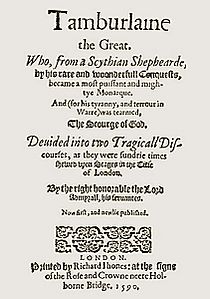
- First Official Record: 1587, for Part I.
- First Published: 1590, both parts together. The author's name was not included.
- First Performance: 1587, Part I, by the Admiral's Men in London.
- Why it's important: Tamburlaine was the first play to use blank verse in English theatre.
- Who wrote it: Marlowe's name was not on the first printing. But experts agree he wrote it. The style and characters are very similar to his other works.
- Evidence: No original handwritten copies by Marlowe exist. Both parts were registered for printing in 1590. They were published together in 1590, 1592, and 1597.
The Jew of Malta (around 1589–1590)

- First Official Record: 1592.
- First Published: 1592. The oldest existing copy is from 1633.
- First Performance: February 26, 1592, by Lord Strange's acting company.
- Why it's important: This play was very popular for 50 years. It shows a strong theme of questioning authority, which is common in Marlowe's works.
- Evidence: No original handwritten copies by Marlowe exist. It was registered for printing in 1594. But the earliest printed version we have is from 1633.
Doctor Faustus (around 1588–1592)
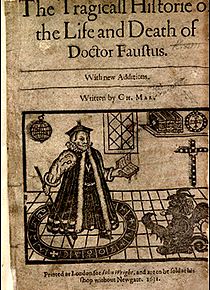
- First Official Record: 1594–1597.
- First Published: 1601 (no copies exist). The oldest existing copy is from 1604.
- First Performance: 1594–1597, with 24 performances by the Admiral's Men. Earlier performances likely happened around 1589.
- Why it's important: This is the first play about the Faust story. It's about a scholar who makes a deal with the devil. Marlowe's version is different because Faustus cannot escape his deal.
- Who wrote it: Later versions of the play were heavily changed. They included scenes by other playwrights. So, some editions credit "Christopher Marlowe and his collaborator and revisers."
- Evidence: No original handwritten copies by Marlowe exist. There are two main printed versions, A and B. Experts debate which one is closer to Marlowe's original.
Edward the Second (around 1592)

- First Official Record: 1593.
- First Published: 1590. The oldest existing copy is from 1594.
- First Performance: 1592, by the Earl of Pembroke's Men.
- Why it's important: Experts see this as Marlowe's "most modern play." It looks closely at a king's personal life. It also shows the power struggles of the time. This play and Dido were the first published plays with Marlowe's name as the author.
- Evidence: The play was registered for printing on July 6, 1593, five weeks after Marlowe's death.
The Massacre at Paris (around 1589–1593)
- First Official Record: Around 1593. There's a handwritten sheet believed to be by Marlowe. But some experts question if he wrote it.
- First Published: Undated, around 1594 or later. This is the most complete text we have. But it's only half the length of Marlowe's other plays. It might be a reconstruction from memory.
- First Performance: January 26, 1593, by Lord Strange's Men. It was called The Tragedy of the Guise.
- Why it's important: This play was considered dangerous. People in London used its themes to encourage violence. It warned Queen Elizabeth I about these dangers. It was the highest-earning play for Lord Strange's Men in 1593.
- Who wrote it: A handwritten sheet is thought to be by Marlowe. But other experts disagree. The only printed text we have might be a reconstruction from memory. It's much shorter than other plays of the time. The writing style also seems uneven.
- Evidence: This play was never officially registered for printing.
Honoring Christopher Marlowe
A bronze statue called The Muse of Poetry honors Marlowe. It was put up in Canterbury in 1891. It now stands outside the Marlowe Theatre in the city.
In 2002, a special window for Marlowe was put in Poets' Corner at Westminster Abbey. It caused some debate because it included a question mark next to his death date. Some experts argued that this question mark should be removed. They said there was enough proof of his death date.
The Marlowe Theatre in Canterbury, UK, was named after him in 1949.
Marlowe in Stories and Media
Marlowe has appeared as a character in many books, plays, films, and TV shows.
Marlowe's Works on Stage and Screen
Radio Shows
- BBC Radio aired adaptations of Marlowe's six plays from May to October 1993.
Royal Shakespeare Company Performances
- Dido, Queen of Carthage: Performed in 2017.
- Tamburlaine the Great: Performed in 1992, 1993, and 2018.
- The Jew of Malta: Performed in 1987, 1988, and 2015.
- Edward II: Performed in 1990.
- Doctor Faustus: Performed in 1974, 1975, 1989, and 2016.
Royal National Theatre Performances
- Tamburlaine: Performed in 1976.
- Dido, Queen of Carthage: Performed in 2009.
- Edward II: Performed in 2013.
Shakespeare's Globe Theatre Performances
- Dido, Queen of Carthage: Performed in 2003.
- Edward II: Performed in 2003.
Malthouse Theatre Performances (The Marlowe Sessions)
In 2022, The Marlowe Sessions presented:
- Dido, Queen of Carthage
- Tamburlaine The Great, Part 1
- The Jew Of Malta
- Tamburlaine The Great, Part 2
- Edward The Second
- The Massacre At Paris
- Dr Faustus
- The Poetry of Christopher Marlowe
Other Stage Performances
- Tamburlaine: Performed at Yale University in 1919 and The Old Vic in 1951.
- Doctor Faustus: Performed at Maxine Elliott's Theatre in 1937 and Royal Exchange in 1981.
- Edward II: Performed in Cambridge in 1951, 1958, and 1969. Also in Washington in 1993, Budapest in 1998, and Crucible Theatre in 2001.
- The Massacre in Paris: Performed in France in 1972.
Stage Adaptations
- Edward II: Adapted for stage in London in 1923. Also adapted by Bertolt Brecht in Germany in 1924. A ballet version was created in 1995.
- Doctor Faustus: Adapted for stage in 2016 and 2020.
Film Adaptations
- Doctor Faustus: A film based on the play, released in 1967.
- Edward II: A film directed by Derek Jarman, released in 1991.
- Faust: A film with some Marlowe dialogue, released in 1994.
See also
 In Spanish: Christopher Marlowe para niños
In Spanish: Christopher Marlowe para niños


